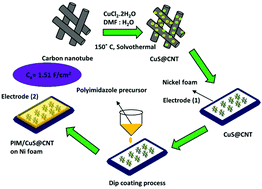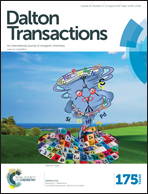Enhanced electrochemical capacitance of polyimidazole coated covellite CuS dispersed CNT composite materials for application in supercapacitors
Abstract
Great attention has been paid to the design and synthesis of distinct core/shell heterostructures for high-performance supercapacitors. We have prepared unique heterostructures consisting of polyimidazole-coated copper sulphide over a carbon nanotube network (CuS@CNT) on nickel foam, which was accomplished through a facile and cost-effective solvothermal method combined with a dip coating process. Hexagonal covellite CuS nanoparticles were dispersed on CNTs using a solvothermal method where dimethylformamide and distilled water were used as solvents. The synthesized CuS and CuS@CNT supercapacitor electrode materials were thoroughly characterized. The polymer supported electrode (PIM/CuS@CNT) shows a high areal capacitance of 1.51 F cm−2 at a current density of 1.2 A g−1, which is higher than the CuS@CNT electrode and many other previously reported CuS electrode materials. After 1000 cycles at a high current density of 1.2 A g−1, the retention rate is 92%, indicating good long-term cycling stability. These results indicate that the PIM/CuS@CNT electrode is promising for high-performance supercapacitor applications.


 Please wait while we load your content...
Please wait while we load your content...